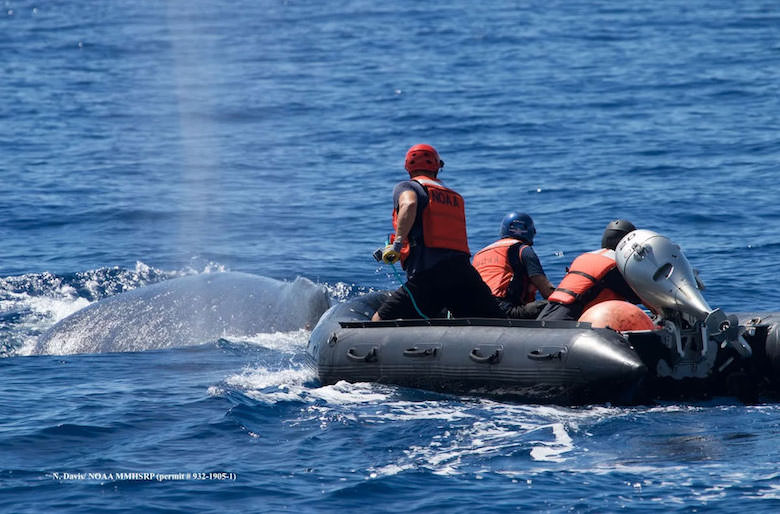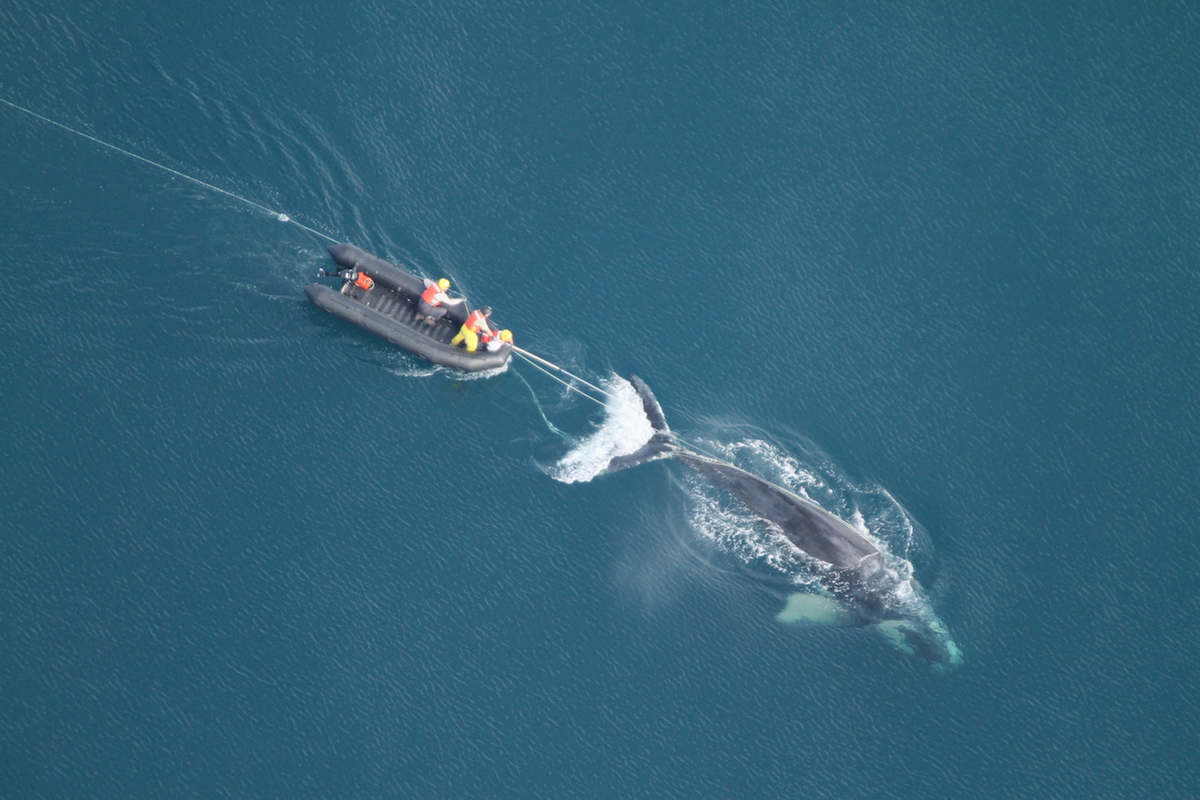- Whales regularly get caught by fishing gear or marine debris, which can wound or kill them. So far this year, 46 entangled whales have been reported off California shores, four times the annual average for the entire continental west coast between 2000 and 2012.
- On the U.S. west coast, crab gear was involved in nearly half of the whale entanglements reported during the past decade.
- This October, around 100 San Francisco-area crab fishermen learned how to identify, report, and monitor whales trapped by fishing gear. The training is part of a larger effort to better understand how and where whales become entangled and what can be done to minimize the harm to these animals.
Mid-November marks the start of California’s commercial Dungeness crab season and in the month that follows, crab fishermen spend long hours along the coast checking their crab pots, repairing gear, and making the most of the lucrative beginning to the season. Last year the crab industry brought in almost $60 million in profits, most of that garnered in the first 15 days of the season.
But this October, around 100 fishermen from three ports near San Francisco took time away from their preparations to learn a new set of skills — how to identify, report, and monitor humpback (Megaptera novaeangliae), and gray whales (Eschrichtius robustus) trapped by fishing gear. The training is part of a larger collaboration between the fishermen, regulators, and conservancy groups to better understand how and where whales are likely to become entangled and what can be done to minimize the harm done to these animals. It’s an attempt by environmental advocates and those who make a living from the ocean to strike a balance that preserves the industry while protecting the world’s largest mammals.
“No one wants to tangle a whale,” crab fisherman Geoff Bettencourt told Mongabay.
But evidence shows that whales regularly get caught by fishing gear or marine debris. According to a detailed study of humpback fluke photographs taken in feeding and mating grounds in the Pacific Ocean, between 20 and 60 percent of the whales’ tails showed scarring patterns that indicated a past entanglement. And crab gear was involved in nearly half of the west coast whale entanglements reported during the past decade, according to National Oceanic and Atmospheric Administration (NOAA) Fisheries.
Bettencourt is a fourth-generation fisherman out of the port of Half Moon Bay, a small town 30 miles south of San Francisco. In his more than 30 years on the ocean, neither he nor any of the other fishermen he knows have seen an entangled whale. But he has seen them in recent TV news stories and knew his industry had to respond. “If the whales are on an upswing, that’s a great thing. We just need to manage the fishing around that,” he said.

This year’s unusually warm ocean waters have brought whales in large numbers to the California coast, as well as a record number of sightings of whales trapped in or dragging fishing gear. So far, 46 entangled whales have been reported, four times the annual average for the entire continental west coast recorded by NOAA Fisheries between 2000 and 2012.
Unlike whale–boat collisions, which often result in a speedy death for the whale, entanglement can be a drawn-out process. Ropes from crab or lobster pots or fishing nets can catch on the whale’s flippers, flukes, or dorsal fin (for humpbacks) or become enmeshed in the baleen plates in its mouth. Dragging the gear can sap the animal’s strength and leave deep cuts in its skin. Large whales entangled in extensive gear have been spotted repeatedly over the course of weeks or months before disappearing and presumably dying. On the U.S. east coast, entanglement is the leading cause of death for large whales.
“One of the biggest problems facing large whale conservation and welfare is whale entanglement,” Michael Moore, a Woods Hole Oceanographic Institution veterinary scientist who has studied whales since 1978, told Mongabay.
The possibility of training the Dungeness crab fishermen to be first responders was suggested by Tom Dempsey, a senior fisheries project director for The Nature Conservancy (TNC), at an August informational meeting for crab fishermen hosted in Oakland by the California Department of Fish and Wildlife, the California Ocean Protection Council, and NOAA Fisheries. In 2013, prior to joining TNC, Demspey helped the Cape Cod Commercial Fishermen’s Alliance organize the training of 60 fishermen by the National Marine Mammal Entanglement Response Program.
The nationwide network is made up of primarily volunteers ranging from those who have attended an introductory session to learn how to document and report injured whales — level 1 — up to those with extensive hands-on training to maneuver a craft close enough to a whale and to be able to cut through the lines — levels 4 and 5. Dempsey likens the level-1 training the lobster fishermen received to a basic CPR course: they may never use it, but if they do encounter an entangled whale, they’ll know who to contact and to do it right away.

“In the past, we’d get notification [from fishermen spotting an entangled whale] after they had come in at the end of the day, we can’t do anything about that,” Pieter Folkens, a level-4 responder for California’s whale disentanglement program, the California Stranding Network, told Mongabay.
Folkens was invited to discuss the network and its goals at a follow-up meeting for crab fishermen in September. He remembered the meeting starting off with the fishermen expressing a lot of acrimony toward NOAA Fisheries. But as he explained that his organization wasn’t out to vilify the crab-fishing industry and that in fact it wanted the fishermen’s help to reduce entangled whale deaths, the atmosphere began to change. “By the end of the day, they were buying us beers and asking us questions,” he said.
This enthusiasm resulted in the October session held in Half Moon Bay and live-streamed to ports in San Francisco and Bodega Bay, 60 miles north of the city. Justin Viezbicke, the coordinator for the California Stranding Network and a level-4 responder, presented an overview of his organization and ways that the crab fishermen could help.
“We want to build out the capacity to respond to these events,” he told Mongabay, adding “we need to have as many people lined up as we can because [entanglements] happen at the most inopportune times.” He noted that the fishermen present at the training would increase his volunteer base by over 10 percent.
The most useful help the fishermen can offer, Viezbicke told the crowd, is to report to his group an injured whale when they sight it and, if possible, to stay with the animal until another boat can arrive. “Once we lose the whale, it’s a needle in a really large haystack,” Viezbicke said.
Also important is to assess the situation, explained Viezbicke: identify the whale, note its condition, what gear is attached, and how. Because fishermen are familiar with the gear, they are well equipped to report this. And the information is valuable beyond saving the whale. “The biggest part of our program right now is documentation and learning about what’s going on out there,” he said.

Figuring out what circumstances lead to crab gear entangling whales is a principal goal of a working group set up this spring by California’s Dungeness Crab Task Force, the government-mandated body that reviews and makes recommendations on the management of the state’s Dungeness crab fisheries. The working group is composed of fishermen and representatives from three government regulatory groups and four conservation organizations.
Based on evidence from the U.S. east coast that whales can avoid lobster-pot lines better when they are vertical and taut in the water than when they are running horizontally or slack, the California working group will study how weighted or floating crab-pot lines behave in the water under different conditions. They plan to test the strength of these lines to find out how easily a whale can break free from them or a whale rescuer’s knife can cut them.
They also want to collect data on the distribution and density of pots, as well as their proximity to whales. To help with this, the coast guard will perform helicopter flyovers during the first weekend of the Dungeness crab season. “We can see right here right now where the pots are, and where the whales are,” Jim Anderson, a crab fisherman and member of both the task force and working group, told Mongabay.
Other fishing ports have requested first responder training sessions, which the working group hopes to organize later in the season. For now, a best practices guide to help Dungeness crab fishermen avoid entangling whales and report distressed whales is available on the California Ocean Protection Council’s website.
Fishermen like Bettencourt believe this collaborative approach is the best chance for the whales, and his industry, to thrive. “The newer generation fishermen realize that the only survivability is in that new way of thinking. It has to be sustainable, it has to be right, it has to have the science to protect it,” he said.
The Dungeness crab season was scheduled to open this year on November 15, but the Department of Fish and Wildlife delayed it indefinitely due to a toxic algal bloom. Andersen told Mongabay that the working group’s ideas will be implemented when the season begins.